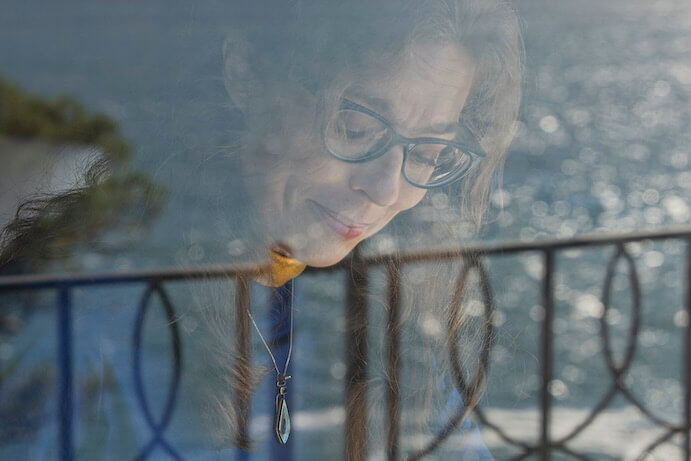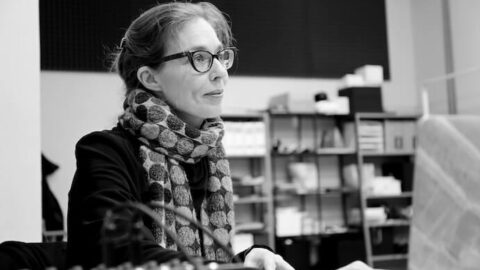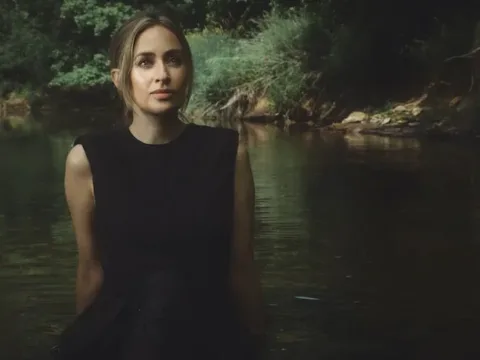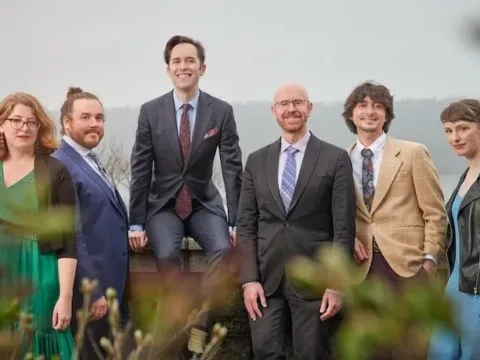These days, Žibuoklė Martinaitytė is based in New York City, but she was born and raised in Lithuania on both sides of Soviet collapse. It’s tempting to categorize her work as a product of cultural disconnect and fragmentation. But to limit ourselves to such a description obscures what makes her music so mesmerizing – a fascination with overtones and microtones, the confines of words, and the multiplicity of beauty.
A 1997 graduate of the Lithuanian Academy of Music and Theatre, Martinaitytė has spent the past two decades accumulating commissions, fellowships, and awards. She is a recipient of the Lithuanian Medal of Honor and a Guggenheim Fellowship, and she has held residencies at MacDowell, Copland House, and the Bogliasco Center. She’s been commissioned by MATA, Bang on a Can, and Lithuanian National Radio, and written works for orchestra, voice, chamber groups, and more.
Her newest album, Aletheia: Choral Works (out Nov. 15 on Ondine Records), features four choral works performed by the Latvian Radio Choir and conductor Sigvards Kļava. The compositions – which were written in 2010, 2018, 2022, and 2023 – are connected through the absence of traditional lyrics. Instead, each work reflects Martinaitytė’s keen perception of the wordless vocal strategies used by humans: ululations, onomatopoeias, or in case of The Blue of Distance (2010), vowel sounds taken from the text of Rebecca Solnit’s exploration of blue in A Field Guide to Getting Lost.
Throughout the album, it becomes clear that Martinaitytė’s exploration of sonic beauty is not predicated on one manifestation. It’s the ways voices and pitches can impact, strengthen, and diminish each other; the sonic possibilities when humans are not restricted to textual enunciation; and the spiritual might of unified voices, even if they are not necessarily singing together.
We had a chance to sit down with Martinaitytė and ask her about her interest in text-less vocal music; what it was like composing at the onset of the Russian-Ukrainian war; and why there’s no end to the study of your craft.
This album is grounded in millennia-long traditions of vocal expression, but in your choral works, words are secondary, if present at all. Do you think we limit ourselves when treating words as the primary method of communication in our day-to-day lives?
In our daily lives we are bombarded by an unceasing stream of verbal information; and we have less and less space where to be without it and just to rest our brain from continuously processing it. Music is one of those spaces. Vocal expression can encompass so much more than words! It can go beyond words, to a pre-verbal communication that is found in the natural world and also between human beings in specific circumstances, not to mention the very first year of our lives.
If we think of those instances when we are really “at loss of words” – either because what we feel is too urgent to be expressed in the intellectualized, thoughtful, and orderly way; or if a feeling has taken us by surprise – if what we feel is too overwhelming, we turn to other more immediate forms of non-verbal expressions such as moaning, sighing, screaming, laughing or other sounds.
Words can be a meaningful and useful tool for communication, yet at the same time, they imply a very particular set of meanings and therefore inherently carry a possibility of misunderstanding. Words can inspire us and words can limit us. In fact, none of my choral pieces on this album have any words. The listeners have often commented after hearing them in concerts that it had been quite a liberating experience because for once they didn’t have to follow the meaning of words, but instead, relax into the musical flow while adhering their own meaning to what they’ve heard.

Following the text often becomes the preoccupation, the primary area of focus for the listener’s brain and then it causes stress if we miss one or two words. When music is telling us the same story as the words, why do we need words if we can experience an adequate emotional sequence in a more immediate way?
The story of how I came about using only vowels and syllables is a curious one, as if based on a reverse logic. I had a commission to write a choral a cappella piece – The Blue of Distance – that is on this album. When choosing excerpts of the poetic text I suddenly had a revelation – why not to extract vowels out of the words and use them instead? I started jotting down the sequence of vowels only to realize a moment later that I actually don’t need the text at all, that I could simply be free and use whatever vowels I wished.
I chose darker vowels for some sections and lighter ones for others, thus creating subtle gradations of sound. In that piece I noticed that by changing vowels on a single elongated pitch, the voice can produce overtones that give a very special timbral color to the sound by adding some unpredictability of the resultant tone that is reminiscent of throat singing found in various Indigenous cultures.
Your bio states that your music “revolves around the notion of beauty,” and there are moments on the album that I find gorgeously haunting. Do you think some listeners hear beautiful and fearful sounds as incompatible?
Our perception of beauty in the aural sense is extremely subjective. It depends on the context we are familiar with, in this case the music that we’ve been exposed to. If we look at various folk traditions, we will see how they feature particular music intervals and harmonies. What is considered beautiful in one culture might not be so in another part of the world.
Let’s say, my native folk tradition of Lithuanian music in one of its most ancient forms highlights parallel motion in major second intervals. It sounds incredibly beautiful to my ears, but perhaps someone might find it “jarring” or “unsettling”. The same is with the interval of the minor third and harmonies built on it – they are embedded in lullabies that I heard in my childhood and for me those are the most organic relationships between two sounds.
Yet somebody with a different cultural background might label the same intervals and harmonies as melancholic, sad, or even depressing. Something that is familiar to us has more potential to be perceived as beautiful due to the familiarity itself. However something unfamiliar might be considered “fearful” at first. When I say “beautiful”, I usually mean safe acoustic spaces where the listener’s ears won’t be assaulted by aural aggression. The notion of beauty changes all the time and it depends mostly on the overall context. A single high-pitched sound heard right after an explosion might not sound beautiful in the harsh reality of war where people are dying, but in a musical context, the very same sound could be transporting, otherworldly, and beautiful…

In the promotional materials for Aletheia, you shared that you started composing the title work just a little before Russia invaded Ukraine. Did your intentions for this work shift because of the conflict? Are there original ideas that carried over into the final version?
Aletheia carries a certain emotional charge that resulted from the situation with the war. We are the voices of the historical times we live in whether we choose to express it consciously or not. Lithuania is next door to Russia and because of the shared terrible history, we have definitely been affected by what has been happening in Ukraine. Why? Because it threatened the crucial human need for freedom. Even though I live in New York, yet my family – my roots – are in Lithuania. I experienced everything the same way they have…
The original creative intention for the piece was to have a multiplicity of voices singing without words. The choir is divided into 16 individual parts. It is like an orchestra of voices that are treated as instruments and layered into various densities of textures. This primary idea was realized in Aletheia.
You’ve continued to pursue composition workshops and courses throughout your career. Why do you feel it’s important to continue to learn and study even after you’ve “made it?”
Learning is an ongoing process and never ends. It is the curiosity about your field that keeps us engaged and open-minded. Most composition workshops and courses in various countries I attended in my twenties right after I graduated. The purpose was to expand my worldview and to get as much exposure to the newest musical styles as possible.
Youth and inexperience contain a lot of “hunger” for your beloved and practiced artform. You want to find out who you are and at the same time to understand the overall musical context…. and this “hunger” and learning continues still today. It is my regular practice and an immense pleasure to look at the scores by other composers especially after hearing a piece for the first time and trying to comprehend how it was notated.
I love how much attention you give to the ways musical lines interact and impact each other. Are there any particular sonorities that you find yourself continually returning to in your repertoire?
I gravitate towards my signature sonorities which are like DNA, like a genetic code that is impossible to escape. The method of layering sounds, of having more layers for a single sonic entity that are not necessarily perceived aurally is also of particular interest to me. This evolves into considerations of density and transparency within the textures, with the multiplicity of lines and relationships between them.
In vocal music I’m drawn to the shifting overtones of a single pitch achieved by changing vowels while sustaining the pitch. It has a certain mystique and a set of unique characteristics, something unexplainable by words….
I CARE IF YOU LISTEN is an editorially-independent program of the American Composers Forum, and is made possible thanks to generous donor and institutional support. Opinions expressed are solely those of the author and may not represent the views of ICIYL or ACF.
You can support the work of ICIYL with a tax-deductible gift to ACF. For more on ACF, visit composersforum.org.




